Time to challenge the flat foot

It’s time to challenge the flat foot given the existence of so many confusing myths. And it’s time to make a challenge and sort out some knowns. Not all flat foot problems should be treated because there are normal variations. Flat foot is an obsession and automatic treatment should be challenged. People think that the arch of the foot must be this shape or that!
Having taught and treated aspects of flat foot for over 40 years I do have strong views as a foot specialist (podiatrist). How much truth is there about flat feet and when should we treat the flat foot? Let me start with some myths. After this we can look at the term ‘pronation’. Overpronation can lead to problems and so a definition is necessary.
Misdirection
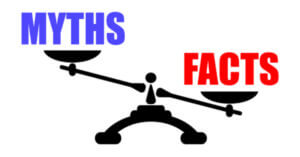
Myths around flat foot shape and arches. Arcady/Shutterstock.com
Electricity myth challenged
Using stimulation of the small muscles in the foot to raise the arch was thought to be a good idea. Scientists from the eighteenth century had pioneered the advent of electricity in animals, such as Galvani in Italy (1791). The use of electricity to stimulate muscles became an important development in medicine, and not just for feet. However those small muscles of the foot are unable to respond to any significant stimulus, and certainly not for the arch. One needs to be made aware that there are muscles and tendons that arise from the legs that are more important. Stimulating the arch of the foot just is never going to work.
Flat foot and the foot soldier

coxy58/shutterstock.com time to challenge the flat foot
During the first part of the 20thcentury in Britain the flat foot excluded any foot soldier from the army. An army depended on the foot soldier when lack of transport forced them to depend on their feet. The army doctor focused on the arch for this reason. Stories like the hunter “who tramped 200 miles out of the bush in order that he might reach Edmonton to enlist, and then tramped back again the 200 miles to his trapping ground after he had been rejected because of his flat feet,” made the exclusion somewhat fallacious (Seiden, H 1992) Flat feet don’t automatically mean bad feet. The Gazette (Montreal) 17 Oct 1992: J6.
The story of the soldier belies a travesty. Many athletes perform well with flat feet and yet a large industry of speculators make spurious claims. Is this good sales pitch? In fact, it was not until the end of the second world war (1939-45), that Harris and Beath in Canada (1947) set up a large study looking at 3619 Canadian soldier’s feet. They developed an ink mat to study pressure and arches, formed an arch index measurement as well as contributed to some of the x-ray shots of the hindfoot -subtalar joint.
“It is a useless waste of time, effort and money to enlist men whose feet will not permit them to undertake the duties of a soldier even though they may have succeeded in finding themselves a niche in civil life in which they can compete on equal terms with their fellows.” Harris, Beath 1947 An Investigation of Foot Ailments in Canadian Soldiers, published in 1947.
“It is evident that we cannot be content merely to recognize the deformity of flat foot. Our concern is with function. If this is good it matters little whether the longitudinal arch is depressed.” These two views conflict with each other but the endgame was it doesn’t matter about shape.
Mis-selling flat foot for profit!

time to challenge the flat foot
Here’s another challenge for the flat foot. There are two forms of misleading the public. The best and first relates to suggesting that an arch has not formed correctly. It is true that some feet have shape problems but these should be diagnosed by specialists in podiatry and orthopaedics. Podiatry specialises wholly in foot science while orthopaedics has sub-specialties in separate parts of the body, one being the foot and ankle. The second technology that baffles the uninformed client is the pressure platform often used to sell certain types of running shoes. Advice maybe given that the foot needs something extra. That extra item is an orthosis or designer shoe which comes with an enhanced price tag.
Cruising for beauty
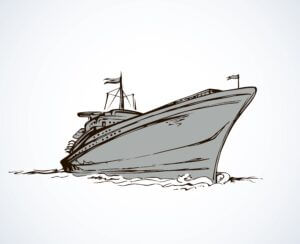
Small cruise liner. ArtMari/Shutterstock.com
My wife and I celebrated my retirement from clinical practice in 2018. We elected to go on a cruise, one which was also equipped with a gym. The range of machines and the size of the gym was impressive given that the ship only had 234 passengers. As I sat astride the cycle I saw a chart on the wall which peeked my interest. The chart showed a foot graded into different arch shapes as illustrated. I have simplified this into three arch shapes in the previous footprint picture. The middle one is classified as normal and the one on the right as ‘pronation’. Now to the professional this only means a movement, to the salesperson, pronation can be used to promote the foot as being abnormal. This means we have to challenge the idea that shape fits into a set plan of action.
The Foot Print Method

A chart to challenge our understanding of types of flat foot as used in the gym.
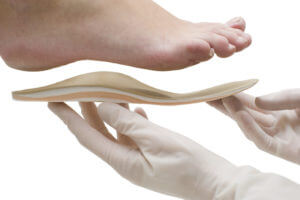
challenging that flat foot with an orthosis might not always be the answer
The six pane print would appeal to some of the passengers of whom a number elected for a beauty treatment. Based on ink prints the terms looked professional like ‘metatarsalgia‘. ‘Pes‘ simply means foot.The bottom middle pane says ‘Pes Planus’. In truth the chart would be of more use to a forensic scientist than suggesting a shape alluded to a foot health problem. Even the bottom right pane suggesting a high arch foot (Pes Cavus) sounds impressive. A true pes cavus would have little of the central arch middle touching the floor s shown.
 The conversation could have gone like this…
The conversation could have gone like this…
“Well you have a flat arch madam and we can see in the chart this is not a normal shape! If I might suggest you need a pair of orthoses as these will help that all important posture. We know posture is important in making us look and feel good. It will also help your back.”
This must be the oldest trick in assessing the foot. Put your foot on the bathroom floor and peer down and see how big an arch you have? So what is pronation?
Definition (pronation)
Think of a gear stick. In the middle we have neutral. Push the stick to the right and this tilts the foot one way, or to the left, the foot tilts the other. Pronation makes the foot flatten out. Supination makes the arch go higher. The only problem lies with the fact that between so called neutral (normal) there are variations in between. If you are in one of those variations and have no symptoms then you do not need to worry. Here is a formal article and definition. You only need to look at the diagrams in this case.
Overpronation & timing contact
Overpronation is used to suggest an abnormal movement leading to a challenge to normal foot function. The big question has always been, does it matter how much we should pronate? Pronation and flat foot do not mean the same thing. Pronation is only a problem if the foot cannot restore the correct balance after contacting the ground. Correction is achieved by having stable interlocking joints about which tendons can work without becoming exhausted.

This YouTube quick film shows how the foot contacts the ground.

If you were to time your foot when it contacts the ground, the clock would time out at 0.6- 0.8 seconds. This is for walking. The amount of time allocated to pronation accounts for around 15% of that ground contact time. In reality anything longer than 0.2 seconds of contact time is going to upset the foot alignment. Such upset comes about because the foot needs to return to the neutral position discussed above.If we run, the speed we travel at reduces the time taken to correct pronation as well as the contact time on the ground. Too much pronation or over pronation can affects sport performance.
Black runners do well at sports, and yet it is well known that Africo-Caribbean feet are naturally flat. The two parts of the foot that make a difference are the hind foot as it attaches to the midfoot. The bones that are most significant are the talus and the calcaneus. The image is in green for the heel bone. These bones and joints make up part of the ankle. The talus (coloured blue in the diagram if you click the link above) joins the main foot through the ankle to the leg. The alignment is critical. If the talus bone is too low, the arch descends and the tendons fail to work in the correct sequence. The position of the heel bone (calcaneus) can also affect the shape of the arch. In Africo-Caribbean feet the heel bone can be pitched quite low and thus gives a flatter foot appearance. This is normal.
What are the symptoms that should concern us?
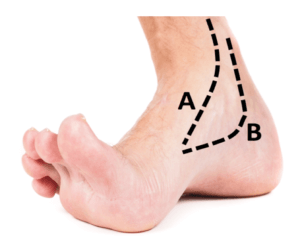
A = Anterior tendon B = Posterior tendon of the ankle
Pain at rest and difficulty walking on surfaces should trigger concerns if symptoms persist. Runners may develop pain suddenly where before they had no problems. The foot might rub on the inside forming blisters or callus or an ulcer. This is notable if the new sign of pressure described seems to have occurred. Tendon pain around the inside ankle or along the arch of the foot (see A & B) may worsen on activity or using equipment like the treadmill in a gym. Pain affecting the large stabilising tendon is also of some concern if it becomes chronic strained (B). This comes under the name posterior tibial tendon dysfunction or (PTTD). The term sounds a bit like post traumatic stress disorder (PTSD) but has nothing to do with psychological stress only physical stress. If your shoe starts to break down on the inside, your foot shape may have changed. The wear marks around the heel and sole may increase. Or you may have to buy shoes more frequently. And so to make this simple here are some key indicators:
- walking pain
- shoe wear increases
- reduced walking distance tolerated
- pressure build up over the skin
Who should you see and what can be done?
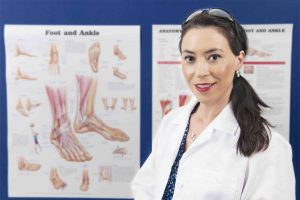 If you elect to buy an orthosis or inlay illustrated earlier, little harm will come to you unless the device hurts. One problem is that thick materials fill up shoes and are a waste of money. Smaller devices sold in some pharmacies are too flimsy to be of any use. Stop using any device you purchase if you develop more pain than before. Some devices can rub and cause blisters. A podiatrist is trained in the science of medical foot health. Podiatrists will ensure that you have options but more importantly they will screen you for any other conditions that might need investigations.
If you elect to buy an orthosis or inlay illustrated earlier, little harm will come to you unless the device hurts. One problem is that thick materials fill up shoes and are a waste of money. Smaller devices sold in some pharmacies are too flimsy to be of any use. Stop using any device you purchase if you develop more pain than before. Some devices can rub and cause blisters. A podiatrist is trained in the science of medical foot health. Podiatrists will ensure that you have options but more importantly they will screen you for any other conditions that might need investigations.
If you truly need an orthosis this can be provided initially at low cost. You do not necessarily require an expensive prescription. Ultrasound, physiotherapy type treatments, taping, extracorporeal shock wave and in some cases injections may be of value. Correct assessment of your walking style together with examination of your footwear pattens will be taken into consideration.
Finding information that has a balanced explanation is often difficult because the concept of flat foot often known as over pronation is complex. This film from Foot Education may be helpful at 4 1/2 minutes long. It comes from the USA https://footeducation.com/foot-types/
Thanks for reading ‘Time to challenge the flat foot’ by David R Tollafield
Published by Busypencilcase Reflective Communications Est. 2015

Published 5 April 2021

Why not sign-up to my regular newsfeed and receive updates
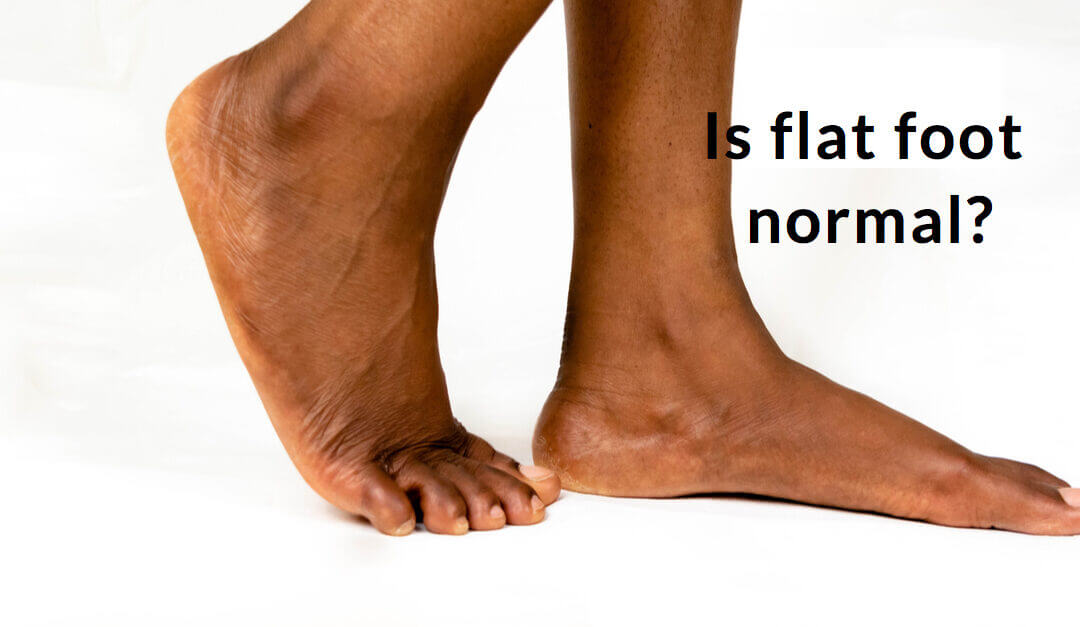
I think who ever invented the myth that people with flat feet couldn’t walk long distances was a genius and saved a lot of people from the Trenches and army service in WW2. I walk 10 miles or more easily with Flat Feet. Perhaps the UK forces in particular should have looked at the the abysmal boots they purchased in both wars and into the 1970s. They would have acquired much more Cannon Fodder for their various military campaigns if they had. I was a Technician in the RAF and it was touch and go whether they rejected me because of this “non-problem”.
Commandos had good rubber soled boots in WW2. Why did everyone else until about 1975, get issued with boots worn by a 1930s Garbage Man, with leather soles and nails in the soles It is beyond belief.